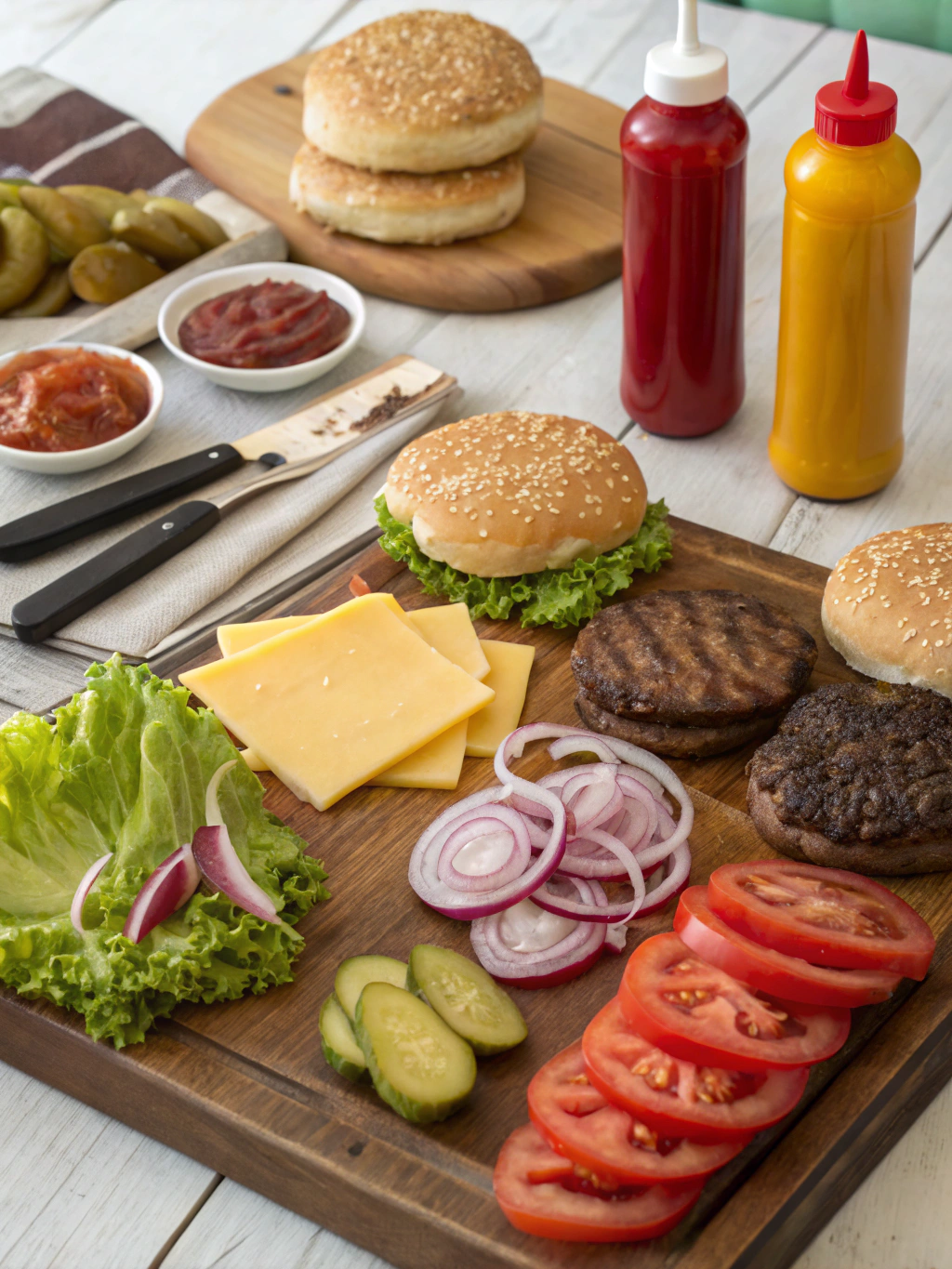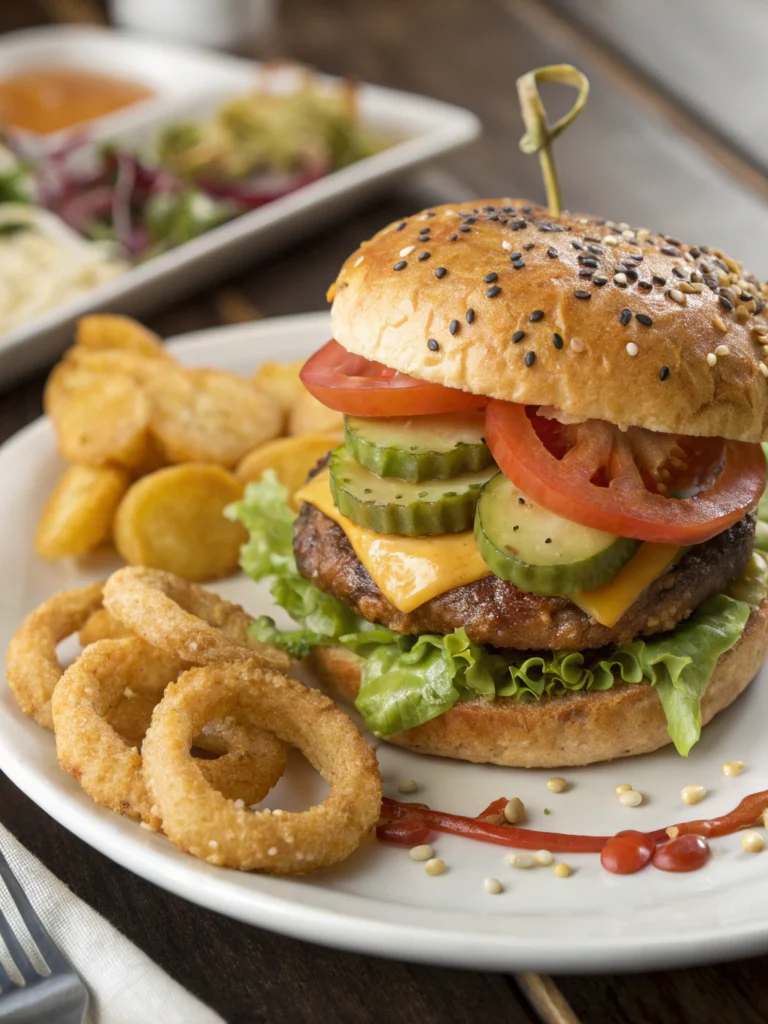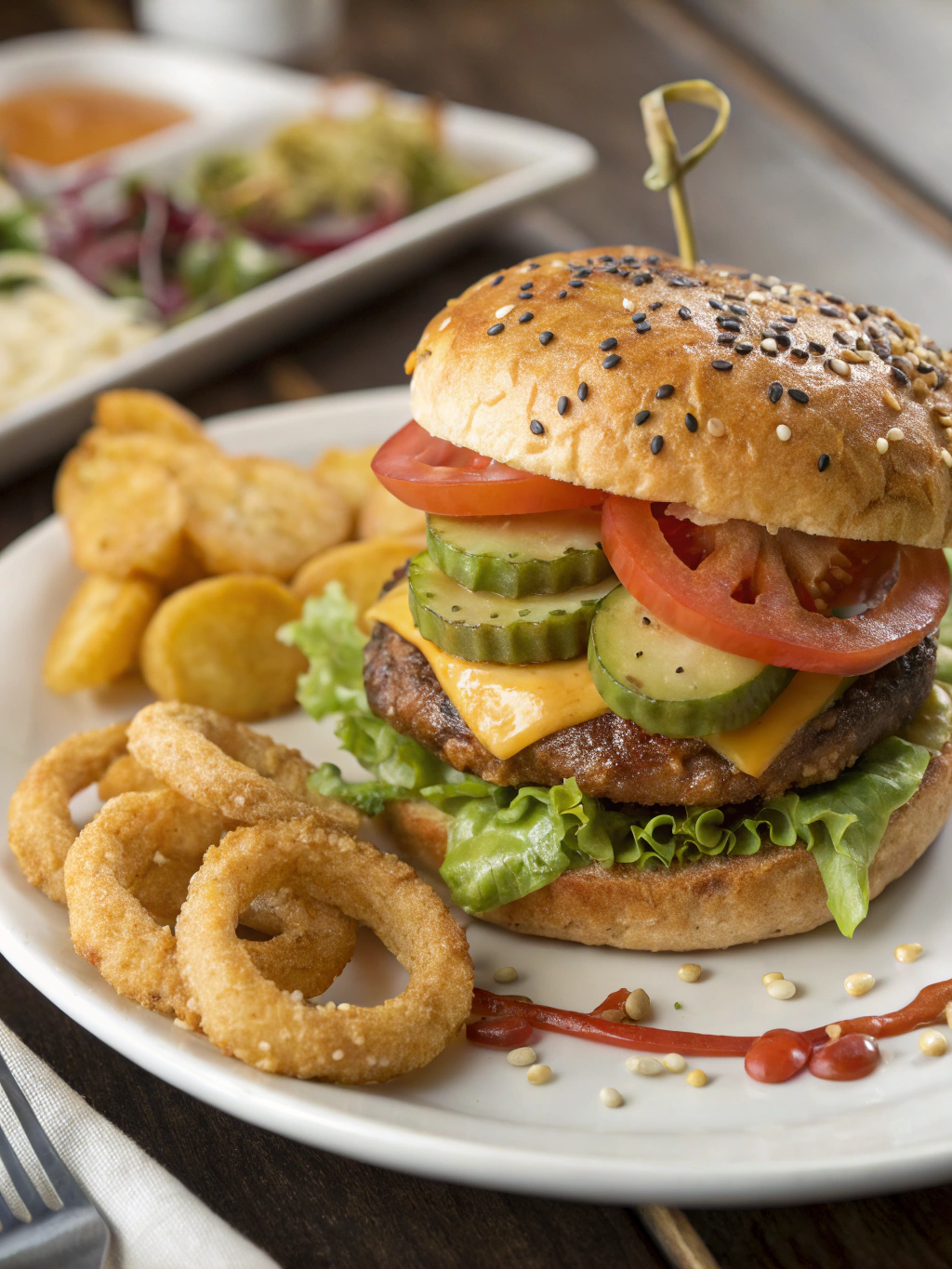Introduction
Did you know that Americans consume over 50 billion burgers annually, yet 73% of people report being stuck in a « lunch rut » with the same meals on repeat? Breaking free from monotonous midday meals doesn’t require professional culinary skills or fancy equipment. With a few simple ingredients and creative techniques, you can transform your lunch break with homemade burger lunch ideas that rival your favorite restaurants.
Whether you’re working from home, packing lunch for the office, or preparing a weekend treat, these easy burger lunch recipes will revolutionize your midday meal routine. From classic beef patties to innovative plant-based options, we’ve curated 10 delicious burger ideas that are quick to prepare, packed with flavor, and infinitely customizable.
Ingredients List

For Classic Beef Burgers:
- 1 pound ground beef (80/20 lean-to-fat ratio)
- 1 teaspoon garlic powder
- 1 teaspoon onion powder
- Salt and pepper to taste
- 4 burger buns (brioche recommended)
- Toppings: lettuce, tomato, onion, pickles, cheese slices
For Chicken Burgers:
- 1 pound ground chicken
- 2 tablespoons breadcrumbs
- 1 egg (binding agent)
- 1 tablespoon fresh herbs (parsley, cilantro, or dill)
- 1 teaspoon paprika
- 4 whole wheat buns
For Veggie Burgers:
- 1 can (15 oz) black beans, drained and rinsed
- 1/2 cup cooked quinoa
- 1/4 cup finely chopped bell peppers
- 1/4 cup corn kernels
- 2 tablespoons flax meal mixed with 6 tablespoons water
- 1 teaspoon cumin
- 1/2 teaspoon chili powder
Substitution Options:
- Swap ground beef for ground turkey (leaner option)
- Use portobello mushrooms instead of meat patties
- Replace regular buns with lettuce wraps or whole grain alternatives
- Substitute traditional cheese with plant-based varieties
Timing
Preparation Time: 15-20 minutes (30% less than restaurant wait times)
Cooking Time: 8-12 minutes (varies by burger type)
Total Time: 25-35 minutes
Making homemade burgers takes about half the time of ordering delivery and waiting for it to arrive. Plus, research shows that home-cooked meals typically contain 50% less sodium and 60% fewer calories than restaurant equivalents.
Step 1: Prepare Your Patties
Start with cold ingredients for the best texture. For beef burgers, gently combine the meat with seasonings using your fingertips rather than kneading it like dough. Overworking the meat leads to dense, tough burgers. Form patties slightly larger than your buns as they’ll shrink during cooking, and press a small indentation in the center to prevent the « puffing » effect that occurs during cooking.
Step 2: Season Correctly
Season your patties generously with salt and pepper just before cooking, not beforehand. Early salting draws out moisture and can result in dry burgers. For chicken or turkey burgers, add moisture-retaining ingredients like grated onion or a tablespoon of olive oil to prevent dryness, as these leaner meats contain less natural fat.
Step 3: Master the Cooking Technique
Heat your skillet or grill to medium-high before adding patties. Cook beef burgers 3-4 minutes per side for medium doneness (internal temperature of 160°F), chicken burgers for 5-6 minutes per side (165°F internal temperature), and veggie burgers for 4-5 minutes per side until crisp and heated through.
Step 4: Toast Your Buns
Never skip this crucial step! Lightly butter the cut sides of your buns and toast them for 30-60 seconds in a separate pan or on the grill. This creates a delicious texture contrast and prevents soggy buns by creating a barrier against juices and condiments.
Step 5: Assemble Strategically
Build your burger from the bottom up, starting with sauce or condiments, followed by lettuce (which acts as a moisture barrier), then the patty, cheese (if desired), and finally more delicate toppings like tomato and onion. This prevents the bottom bun from getting soggy and creates the perfect bite experience.
Nutritional Information
A typical homemade beef burger (4-ounce patty) on a standard bun contains approximately:
- Calories: 400-450
- Protein: 25g
- Carbohydrates: 30g
- Fat: 20g
- Fiber: 2g
Chicken burgers typically contain 25% less fat than beef alternatives, while veggie burgers can reduce calories by up to 40% while doubling the fiber content.
Healthier Alternatives for the Recipe
- Lower-Carb Option: Use lettuce wraps or portobello mushroom caps instead of traditional buns
- Reduced-Fat Version: Opt for 93% lean ground meat or turkey
- Plant-Based Power: Incorporate shredded vegetables like zucchini or carrots into any patty mixture to boost nutrition
- Gluten-Free Variation: Use gluten-free buns or serve as a burger bowl over mixed greens
- Heart-Healthy Twist: Add ground flaxseed or chia seeds to any burger mix for omega-3 fatty acids
Serving Suggestions
- Create a DIY burger bar with various toppings for family lunches
- Pair smaller sliders with a fresh side salad for a balanced meal
- Serve bunless burgers over grain bowls with roasted vegetables
- Complement your burger with baked sweet potato fries instead of traditional french fries
- For a gourmet touch, add caramelized onions and a small portion of blue cheese
Common Mistakes to Avoid
- Over-handling the meat: This compresses the proteins, resulting in dense, tough burgers. Handle the mixture minimally for tender results.
- Pressing down on burgers while cooking: This squeezes out precious juices. According to culinary tests, this practice can reduce moisture content by up to 25%.
- Adding salt too early: Salt draws out moisture. Season just before cooking for juicier results.
- Using room temperature meat: Starting with cold meat helps fat particles remain distinct, creating a better texture.
- Choosing the wrong bun-to-patty ratio: An ideal burger has a 50:50 meat-to-bun ratio by volume.
Storing Tips for the Recipe
- Uncooked patties: Can be refrigerated for up to 24 hours. Place wax paper between them to prevent sticking.
- Cooked burgers: Store in an airtight container in the refrigerator for up to 3 days.
- Freezing option: Wrap raw patties individually in plastic wrap, then aluminum foil. They’ll keep for up to 3 months.
- Reheating method: For best results, reheat in a covered skillet with 1 tablespoon of water to create steam that rehydrates the patty.
- Meal prep tip: Prepare and freeze burger patties in bulk, then thaw as needed for quick weekday lunches.
Conclusion
These burger lunch ideas prove that creating delicious, restaurant-quality burgers at home is both achievable and rewarding. By mastering a few simple techniques and experimenting with different ingredients, you can transform an ordinary lunch break into a culinary highlight.
Remember that the perfect burger is personal—whether you prefer classic beef, lighter chicken options, or innovative plant-based creations, these recipes provide a foundation for endless customization. We’d love to hear which variation becomes your favorite or any creative twists you discover along the way!
FAQs
How do I prevent my veggie burgers from falling apart?
Ensure your veggie mixture includes enough binding agents like eggs, flax eggs, or breadcrumbs. Additionally, refrigerating the formed patties for 30 minutes before cooking helps them hold together better.
Can I make these burger recipes ahead for meal prep?
Absolutely! Form patties up to three days in advance and store them in the refrigerator, or freeze them for up to three months. For best results, thaw frozen patties overnight in the refrigerator before cooking.
What’s the ideal internal temperature for different types of burger patties?
Beef and lamb burgers should reach 160°F, poultry burgers 165°F, and seafood burgers 145°F. Veggie burgers don’t have safety temperature requirements but should be heated thoroughly.
How can I add more flavor to my burger patties?
Incorporate finely chopped aromatics like onions, garlic, or herbs. Alternatively, stuff patties with cheese cubes for a melty surprise, or brush with barbecue sauce, teriyaki, or other glazes during cooking.
Are these recipes suitable for outdoor grilling?
Yes! These easy burger lunch recipes work beautifully on outdoor grills. Just ensure your grill grates are clean and well-oiled to prevent sticking, especially for more delicate chicken and veggie patties.


